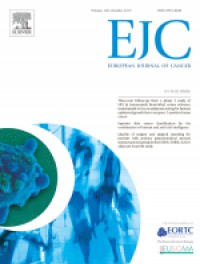European Journal of Cancer Q1 Unclaimed
European Journal of Cancer is a journal indexed in SJR in Oncology and Cancer Research with an H index of 256. Journal with a Single blind Peer Review review system, and It has a price of 2655 €. The scope of the journal is focused on Cancer, Oncology, Clinical Oncology, Medicine. It has an SJR impact factor of 2,691 and it has a best quartile of Q1. It is published in English. It has an SJR impact factor of 2,691.
European Journal of Cancer focuses its scope in these topics and keywords: cancer, patients, cell, advanced, tumour, carcinoma, colorectal, lung, cd, chemotherapy, ...
Type: Journal
Type of Copyright:
Languages: English
Open Access Policy: Open Choice
Type of publications:
Publication frecuency: -


2655 €
Inmediate OANPD
Embargoed OA0 €
Non OAMetrics
2,691
SJR Impact factor256
H Index392
Total Docs (Last Year)1795
Total Docs (3 years)12786
Total Refs8867
Total Cites (3 years)1519
Citable Docs (3 years)4.38
Cites/Doc (2 years)32.62
Ref/DocOther journals with similar parameters
Molecular Cancer Q1
JAMA oncology Q1
Journal of Thoracic Oncology Q1
Cancer Discovery Q1
Neuro-Oncology Q1
Compare this journals
Aims and Scope
Best articles by citations
I.4 Effects of anti-oestrogens on insulin-like growth factor (IGF-I) physiology systemically and in the uterus
View moreMaintaining abstinence from cigarette smoking: effectiveness of group counselling and factors predicting outcome
View more74 O - Selective anti-leukemic potential of HLA-incompatible bone marrow transplants
View moreSurveillance for stage I testicular germ cell tumours
View moreChromophilic renal cell carcinoma: Characterization of four permanent cell lines
View moreIs there a standard adjuvant treatment for rectal cancer?
View moreMetallothionein and Fas (CD95) are expressed in squamous cell carcinoma of the tongue
View moreIs the time interval between diagnosis and radiation treatment an important factor in brain metastases?
View moreThe use of national registers of radiation exposure in occupational radiation risk assessment
View moreApoptosis of Ovarian carcinoma cells (N1) by TNF and it's possible targets
View moreTime trends in ovarian cancer mortality in Europe (1955-1993)
View moreBile duct stents: Is there an increased rate of complications in patients receiving chemotherapy?
View moreAll-trans retinoic acid enhances gap junctional intercellular communication among renal epithelial cells in vitro treated with renal carcinogens
View moreDocetaxel in combination with 5-fluorouracil in patients with metastatic breast cancer previously treated with anthracycline-based chemotherapy
View more163 O - Aortic infuslon (ADM, MMC, CDDP) and stop-flow (MMC, ADM) for systemically pretreated and progresslve FLGO III c and IV ovarian cancer-45 patients
View moreCombined intensive chemoradiotherapy for organ preservation in patients with resectable and non-resectable oesophageal cancer
View moreA novel herpes vector for the high efficiency transduction of primary hematopoietic cells
View morenm23 Protein expression in larynx cancer and the relationship with metastasis
View moreCancer information: a cost-effective intervention
View moreA high pretreatment serum level of VEGF is associated with poor outcome in small cell lung cancer
View more26 P - Monitoring of neurotoxicity of taxanes
View moreA Glimpse of the Future. New Directions in the Treatment of Colorectal Cancer
View more13-Cis-retinoic acid and alphainterferon in advanced squamous cell cancer of the oesophagus
View moreThe role of desmosomal glycoproteins in the adhesion & invasion of human breast cancer cells
View more
Comments